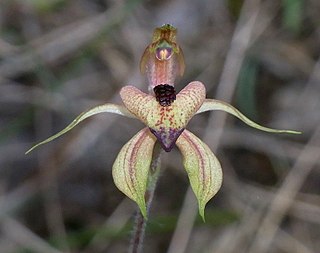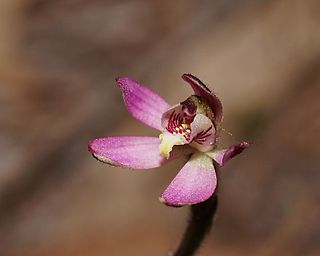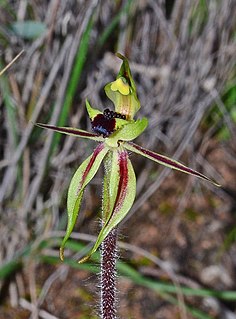
Caladenia cardiochila, commonly known as thick-lipped spider-orchid, fleshy-lipped caladenia and heartlip spider-orchid, is a plant in the orchid family Orchidaceae and is endemic to Victoria and South Australia. It is a ground orchid with a single hairy leaf and one or two yellowish-green, red-striped flowers on a thin, wiry stem.
Caladenia conferta, commonly known as the crowded spider orchid or coast spider-orchid, is a plant in the orchid family Orchidaceae and is endemic to a restricted area in South Australia. It is a ground orchid with a single hairy leaf, and usually a single yellowish-green flower with red markings on a wiry, hairy stalk.

Caladenia congesta, commonly known as black-tongue caladenia, is a plant in the orchid family Orchidaceae and is endemic to Australia. It is a ground orchid with a single, sparsely hairy leaf, and up to three bright pink flowers with the central part of the labellum completely covered with black calli. It is a widespread species but not common in any part of its range.
Caladenia exilis subsp. exilis, commonly known as the salt lake spider orchid, is a plant in the orchid family Orchidaceae and is endemic to the south-west of Western Australia. It is a relatively common spider orchid with a single erect, hairy leaf and up to three white to greenish-cream flowers with a small white, red-striped labellum.

Caladenia filamentosa, commonly known as daddy-long-legs, is a plant in the orchid family Orchidaceae and is endemic to eastern Australia. It is a ground orchid with a single hairy leaf and up to four, usually dark red flowers with long, drooping lateral sepals and petals.

Caladenia fragrantissima, commonly known as the scented spider orchid, is a plant in the orchid family Orchidaceae and is endemic to Victoria and South Australia. It is a ground orchid with a single hairy leaf and up to three creamy-white to yellowish-green flowers. It is possible that it is conspecific with Caladenia orientalis.
Caladenia incensum, commonly known as the glistening spider orchid is a species of orchid endemic to the south-west of Western Australia. It has a single, hairy leaf and three glistening white flowers which have a red-striped labellum.

Caladenia attingens subsp. attingens, commonly known as the forest mantis orchid or sneezing spider orchid, is a species of orchid endemic to the south-west of Western Australia. It is a relatively common orchid with a single erect, hairy leaf and one or two green, yellow and red flowers. It is similar to the fringed mantis orchid but has smaller flowers and has a more southerly distribution.

Caladenia attingens subsp. gracillima, commonly known as the small mantis orchid, is a species of orchid endemic to the south-west of Western Australia. It is a relatively common orchid with a single erect, hairy leaf and one or two green, yellow and red flowers. It differs from subspecies attingens in having smaller flowers and a more easterly distribution.
Caladenia melanema, commonly known as the ballerina orchid, is a species of orchid endemic to the south-west of Western Australia. It is a rare orchid with a single erect, hairy leaf and one or two cream-coloured to pale yellow flowers with red markings and black tips on the sepals and petals.

Caladenia mentiens, commonly known as lesser fingers, is a species of orchid endemic to south-eastern Australia which grows singly, or in small, loose groups. It has a single, sparsely hairy, erect, linear leaf and a single whitish or pinkish coloured flower with a darker back and a cream-coloured labellum.

Caladenia microchila, commonly known as the western wispy spider orchid, is a species of orchid endemic to the south-west of Western Australia. It is relatively common orchid with a single erect, hairy leaf and up to three wispy white flowers with narrow lateral sepals and petals and a white labellum with red markings.
Caladenia necrophylla, commonly known as late green-comb spider orchid, is a species of orchid endemic to South Australia. It has a single leaf and a single yellowish-green flower with red lines along the sepals and petals. It is unusual in that the leaf has completely withered before the flower opens, and sometimes even before the flower spike appears.

Caladenia ovata, commonly known as the Kangaroo Island spider orchid is a plant in the orchid family Orchidaceae and is endemic to South Australia. It is a ground orchid with a single hairy leaf and one or two red flowers, sometimes with yellow patches. It is only found on Kangaroo Island and nearby Fleurieu Peninsula.

Caladenia pusilla, commonly known as tiny fingers, pygmy caladenia, tiny caladenia or pink fingers, is a plant in the orchid family Orchidaceae and is native to Australia and New Zealand. It is a ground orchid with a single erect, sparsely hairy leaf and a single pink flower with a brownish-pink back. The flowers are short-lived and self-pollinating.

Caladenia reticulata, commonly known as the veined spider orchid, is a plant in the orchid family Orchidaceae and is endemic to Victoria and South Australia. It is a ground orchid with a single, hairy leaf and usually only one yellowish-green and red flower.

Caladenia verrucosa, commonly known as the mallee spider orchid, is a plant in the orchid family Orchidaceae and is endemic to south-eastern Australia. It is a ground orchid with a single, hairy leaf and usually only one greenish-yellow and red flower.

Caladenia septuosa, commonly known as the Koppio spider orchid, is a plant in the orchid family Orchidaceae and is endemic to South Australia. It is a ground orchid with a single erect, sparsely hairy leaf and usually only one greenish-cream flower with red stripes along the sepals and petals.

Caladenia toxochila, commonly known as the bow-lip spider orchid is a plant in the orchid family Orchidaceae and is endemic to south-eastern Australia. It is a ground orchid with a single, sparsely hairy leaf and one or two yellowish-green flowers with red stripes. It occurs in Victoria and South Australia and resembles the related Caladenia concinna from New South Wales.

Caladenia valida, commonly known as the robust spider orchid, is a plant in the orchid family Orchidaceae and is endemic to south-eastern continental Australia. It is a ground orchid with a single sparsely hairy leaf and up to three white to cream-coloured flowers which sometimes have red streaks. It is similar to Caladenia reticulata but is large and taller with more stiffly spreading lateral sepals and petals.
























